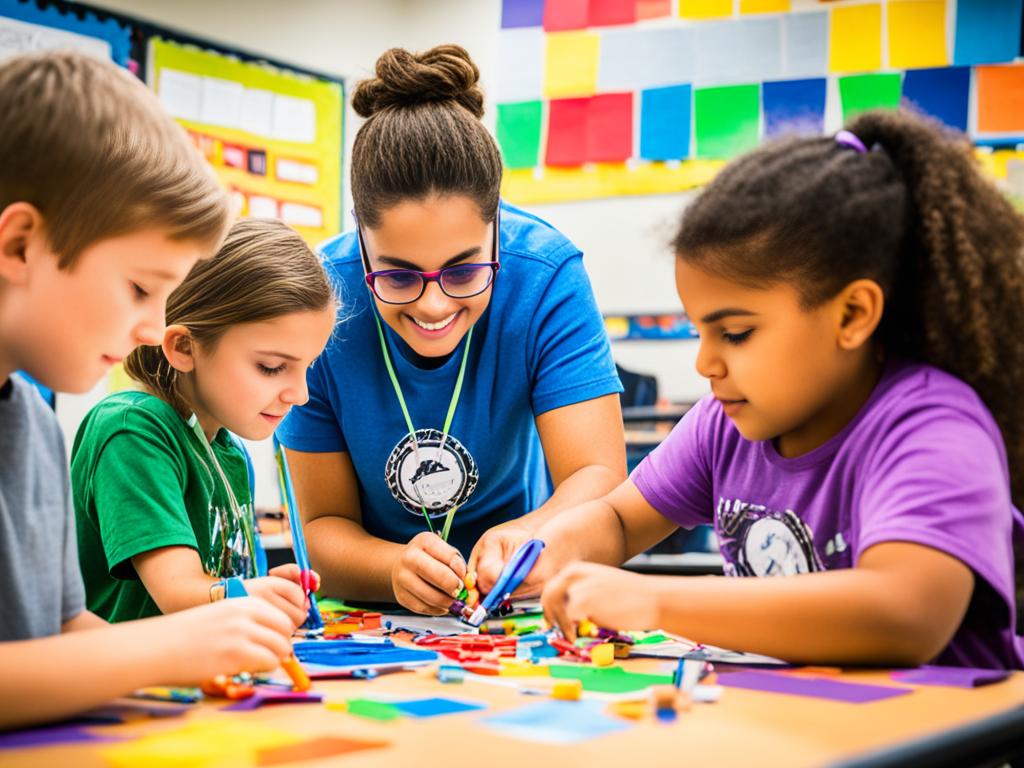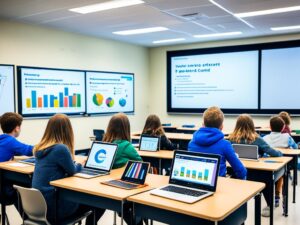
Project Based Learning: Benefits and Implementation Strategies
Project based learning (PBL) is a new way to teach that makes learning fun and real. It helps students work together and think deeply. By solving real-world problems, students connect what they learn in class to their everyday lives.

PBL puts students at the center of their learning. It makes them want to dive into complex issues. They learn to solve problems together, which improves their understanding and skills.
This method does more than just teach facts. It prepares students for the future by teaching them to be adaptable, creative, and problem solvers. These skills are key in today’s job market.
This article will explain the main ideas behind PBL. It will talk about its benefits and how teachers can use it in class. By using PBL, we can help students face the challenges of the 21st century with confidence and creativity.
Unlocking the Power of Project Based Learning
Project Based Learning (PBL) is a new way to teach that lets students tackle real-world problems. They work together to find solutions through inquiry-based learning. At its core, PBL focuses on the student and uses real-world tests to see how well they apply what they’ve learned.
What is Project Based Learning?
Project Based Learning makes learning active and engaging. Students dive into real, complex questions or challenges. This method moves away from just listening and encourages students to lead their own learning.
Key Principles of Project Based Learning
The main ideas of Project Based Learning are:
- Student-Centered Instruction: PBL lets students take charge of their learning. It boosts their curiosity, critical thinking, and problem-solving abilities.
- Authentic Assessments: Real-world assessments are used to see if students can apply what they know to real tasks.
- Interdisciplinary Approach: PBL combines different subjects to help students tackle complex issues from various angles.
By following these principles, Project Based Learning helps students grow. It gives them a deeper understanding of the world and the skills they need for the 21st century.

Fostering Collaborative Learning and Problem-Solving Skills
Project Based Learning (PBL) is a great way to help students learn to work together and solve problems. It’s key for doing well in today’s job world. Students work on projects in teams, sharing ideas and solving big challenges together.
PBL makes students learn to talk well, think deeply, and solve problems. It gets them ready for the real world, where jobs change a lot.
When students work on PBL projects, they learn to:
- Communicate and share ideas effectively
- Think critically to identify and solve problems
- Develop creative solutions to complex challenges
- Coordinate their efforts and leverage each team member’s strengths

PBL teaches important skills for today’s world, like working together and solving problems. It makes learning fun and focused on the student. This way, students get ready for the fast-paced, changing job world.
Project Based Learning: Bridging the Gap Between Theory and Practice
In education, there’s a big push to link theory with real-world skills. Project Based Learning (PBL) is a key method that combines real-world applications and authentic assessments into learning. It lets students take an active role in their education.
Real-World Applications and Authentic Assessments
PBL believes in student-centered instruction and tackling real challenges. It moves away from just reading books. Instead, students work on real-world problems that they might face in their careers or everyday life.
- Through project-based tasks, students use what they’ve learned to solve real problems. This helps them understand their subjects better.
- PBL also uses authentic assessments, like presentations and tasks, to check how well students learn. These assessments look at the whole student, not just their grades.
- These assessments show how well students can think, work with others, and share their ideas clearly.
PBL combines real-world applications and authentic assessments well. This helps students gain skills that go beyond just knowing the material. It prepares them for the real world.

Project Based Learning closes the gap between theory and practice. It turns students into student-centered problem-solvers, thinkers, and communicators. These skills are key in today’s fast-changing world.
Cultivating 21st-Century Skills Through Project Based Learning
In today’s fast-changing world, it’s crucial to teach students key skills for the modern job market. Project Based Learning (PBL) is a powerful way to do this. It makes learning fun and helps students get the skills they need to do well in a tech-driven world.
PBL focuses on teaching skills like problem-solving, critical thinking, collaboration, and communication. By working on real projects, students get to practice these important skills.
When students tackle tough challenges in PBL, they learn to think critically and come up with creative solutions. This helps them be ready for the fast-paced work world.
Working together in teams is a big part of PBL. Students learn to communicate well, work together, and use everyone’s strengths. This teamwork skill is vital for many jobs today.

Using Project Based Learning, schools can help students get ready for the 21st-century job market. Skills like critical thinking, problem-solving, teamwork, and communication are key to success now and in the future.
Inquiry-Based Learning: A Student-Centered Approach
Project Based Learning (PBL) makes students the leaders of their learning. It’s a way to learn by asking questions and finding answers. Students get to explore complex problems and come up with solutions on their own.
This method makes learning more engaging and motivating. Students feel they have a say in what they learn and how they learn it. This approach helps them take charge of their education.
Encouraging Active Learning and Engagement
PBL makes students curious and eager to learn more. They don’t just memorize facts. They dive deep, ask tough questions, and find new solutions.
This way of learning boosts critical thinking, problem-solving, and teamwork. Students work together to solve challenges and discover new things.
With PBL, students feel like they’re in control of their learning. They get to decide what they want to learn. This makes them more invested in their education. It also helps them do better in school and prepares them for the future.
FAQ
What is Project Based Learning?
Project Based Learning (PBL) is a new way to teach that makes students solve real-world problems. Students work in teams to find solutions and share their results.
What are the key principles of Project Based Learning?
PBL focuses on students and uses real-world projects. It teaches skills like critical thinking and teamwork. Students learn to solve problems and communicate well.
How does Project Based Learning foster collaborative learning and problem-solving skills?
In PBL, students work together to solve big challenges. They share ideas and learn to communicate and think critically. These skills are key for success today.
How does Project Based Learning bridge the gap between theory and practice?
PBL uses real-world problems to make learning meaningful. Students apply what they learn in practical ways. They also get assessed through tasks and presentations.
How does Project Based Learning cultivate 21st-century skills?
PBL helps students develop skills like critical thinking and problem-solving. These skills are important in today’s fast-paced job market. Students learn to work well with others and communicate effectively.
How does Project Based Learning encourage active learning and engagement?
PBL is all about students taking charge of their learning. It makes learning fun and meaningful. Students are motivated and feel in control of their education.



This article is really nice and impactful
Thanks for sharing implementation strategies! What are some effective ways to assess student learning and progress in a PBL environment?